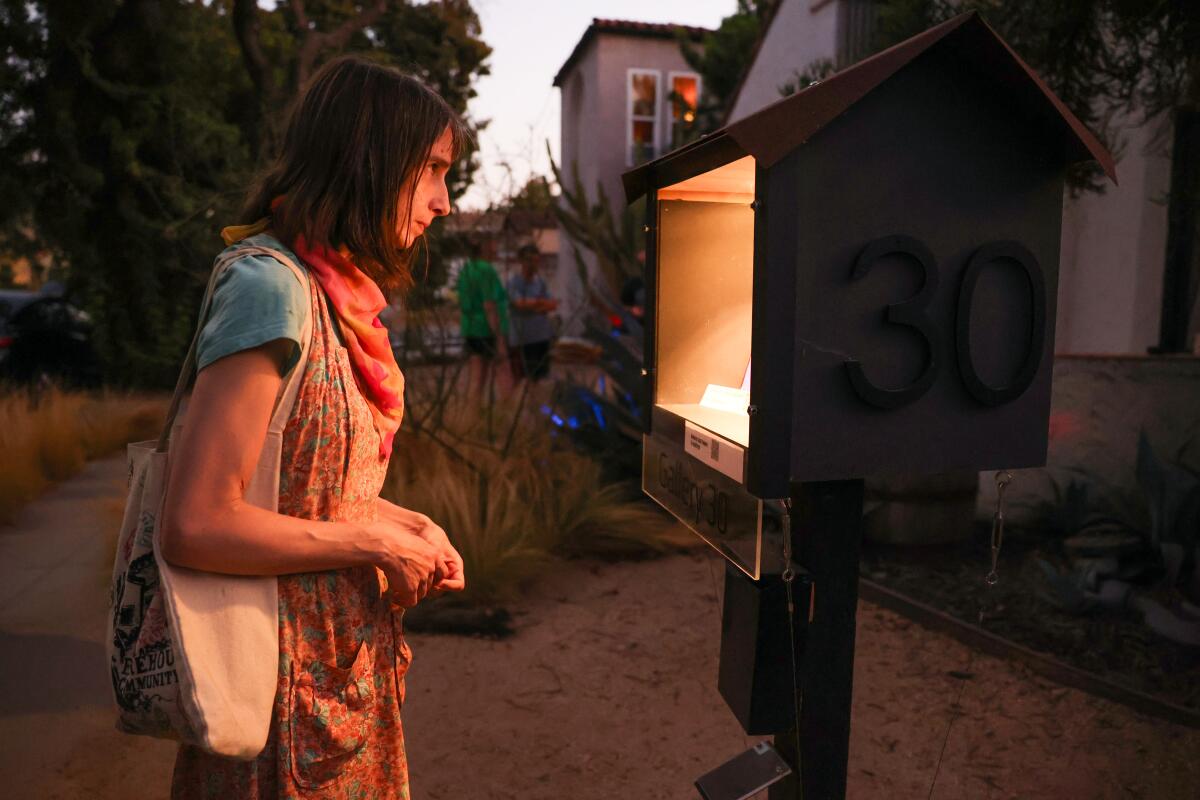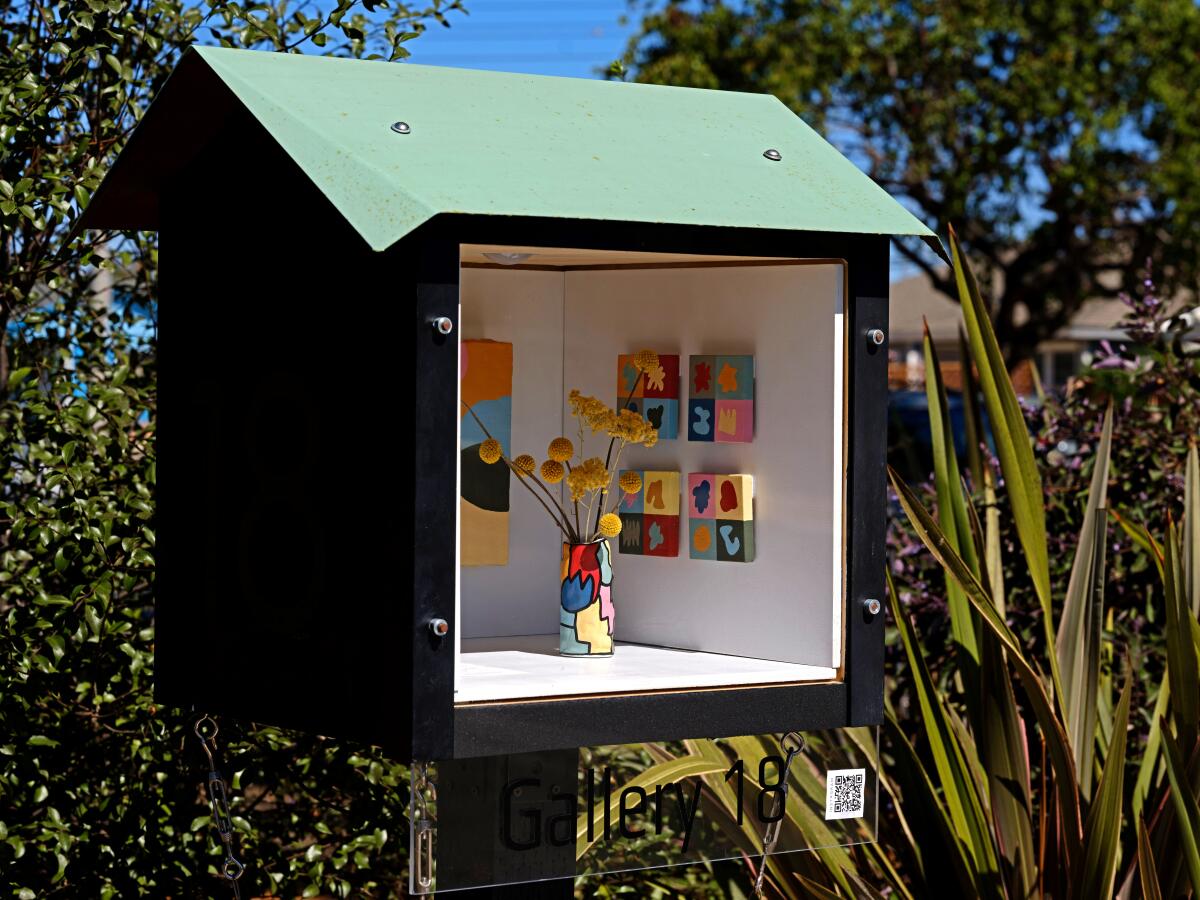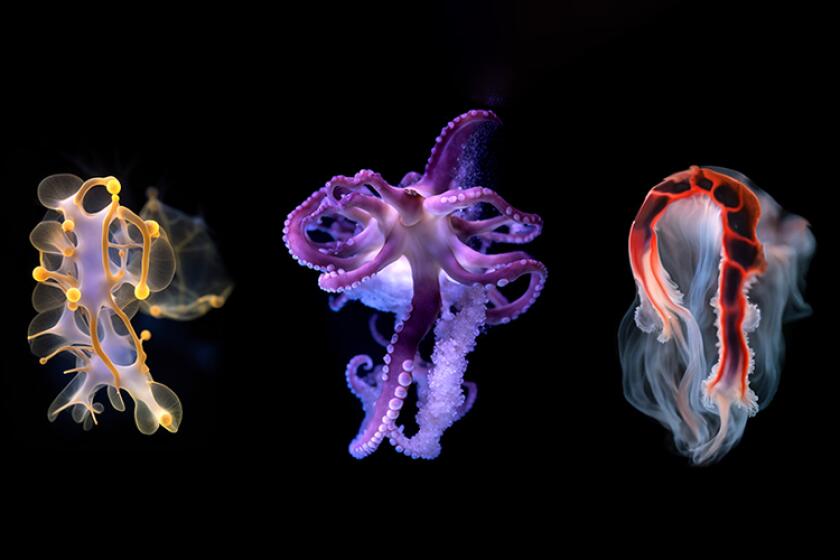In Long Beach and beyond, micro-galleries turn neighborhoods into mini-art districts

- Share via
Two years ago, Long Beach artist Dave Clark exhibited a small sculpture of his called “Together. Forever. Maybe. Regret” at the local Mantel Gallery — itself a small, repurposed Little Free Library that does double duty: When it’s not filled with books, it displays the works of artists like Clark.
At the time, Clark and his wife, Carol, were struck by the concept. “That’s cool,” he said. “But what if I had something bigger? You can put more art in there, and it becomes more of a real functional art gallery.” While his neighborhood had many artists, he noted, it did not have any galleries.
Inspired, he designed and built a micro-gallery measuring about 16 inches wide and 14 inches tall. It has movable walls, a floor and a ceiling that could be adapted for rotating artworks; a solar panel powers the little ceiling light. He installed it on the front yard of their house in the Wrigley neighborhood. They named it Gallery 17, the sum of the numbers on their Eucalyptus Avenue address.
A staff memo at the Los Angeles County Museum of Art indicates construction is further delayed, but when it is completed, the museum expects to hold programming inside the empty building before its official opening.
Last summer, the couple organized an exhibit by local artist Cody Lusby. About 40 people showed up. One of their neighbors saw it and wanted a Clark micro-gallery too. Soon, others began commissioning Clark to build micro-galleries on their front lawns. And then, artists from around Los Angeles and as far away as Ecuador began asking to show their works in them.
An archipelago of 10 micro-galleries stretches around neighborhoods in Long Beach as well as in San Pedro and Lomita. Two more, also in Long Beach, are set to be built in the coming weeks.
“I built them with the idea of an alternative venue for artists to exhibit their work in a public space,” said Clark, who notes the gallerists have held about 25 openings — on the first Saturday of every month — since his inaugural show.

At a time of dwindling support for public arts and artists, these micro-galleries have created neighborhood art districts, providing places to show work while also generating new forms of cultural engagement.
“It’s important that art become a part of everyday life,” said Linda Grimes, executive director of the San Pedro Waterfront Arts District, who’s husband commissioned a micro-gallery for her birthday in April. “Not everybody feels welcome going into an art gallery or a museum. We started painting those traffic signal boxes so that people could see art and appreciate it outside, on the street every day. And then we painted large scale murals. This is just another way to show our support for our art and artists.”
Eric Almanza, a classically trained oil painter, planted his Gallery 99 (if he played sports that would be his jersey number, he said) last October in front of his house in Long Beach’s South of Conant neighborhood.
“I thought what a great idea Dave had,” Almanza said. “Instead of books, this has little masterpieces that can brighten someone’s day. There’s been many times I’ve headed outside the house to run an errand and encounter someone at the box looking inside. There’s been several people who told me they look forward to seeing new work, when it changes.”
The much-anticipated reopening of the Mark Taper Forum, ‘Lightscape’ at Disney Hall, a big debut in San Diego: Here’s our shortlist to the most promising shows in the season ahead.
Almanza, whose own photo realistic paintings examine the nexus between politics, culture and identity with a focus on the border wall and immigration, initially made scaled down prints to show in the box and sold them for $50.
Subsequently, Almanza, who is also a teacher at the HArts Academy, a humanities and arts school in Harbor City, curates works on a monthly basis between March and November by other artists such as Los Angeles-based painter Andrew Ruano. He has also created contests with his students to display their works. Almanza said he wants to connect with international artists, starting with one from Mexico City.
“I like the idea of being able to bring art to the masses in the community,” he said. “I think nowadays we don’t see much public art. I feel like art in general is not as appreciated as in the past. This felt like a good way for artists to show their work and to put public art in my neighborhood.”
For Clark, that is essentially the point.

For the record:
12:25 p.m. Sept. 19, 2024An earlier version of this article contained a photo caption that erroneously stated Bobby Bancalari’s last name as Bangalore.
Since retiring in 2016 after teaching fifth-grade math and science for 31 years, Clark, who had always created multimedia works out of his garage studio, turned to art full-time. He founded Art Clout, a visual arts hub connecting other creatives, but he had long grown tired of the elitism and what he calls the “pay to play” process whereby art galleries charged nonrefundable fees for art submissions but chose only a select few to be shown. “I’m spending, you know, several hundred dollars a year getting in various places just for exposure.”
Clark charges $450 for the materials, construction and installation; gallerists must curate their own box. The artists receive 100% of the profits for any work sold.
Five micro-galleries in Clark’s neighborhood are within walking distance. “In one neighborhood, you can just walk around and see several galleries exhibiting different artwork and different styles,” he said.
One artist created an underwater seascape, he said, and another is planning a sound installation.
The latest installment of Pacific Standard Time, the museum series that this year is titled ‘PST Art: Art & Science collide,’ has arrived. Here’s our shortlist of exhibitions and events.
Recently one of Clark’s neighbors exhibited his partner’s father’s work. “He’s an artist in his 80s and has the onset of dementia,” Clark said. “We had his artwork here, they brought him down. I don’t know how much he was aware of what was really going on, but it was like, this is what this is all about.”
Clark said some artists who’ve shown in museums, universities and galleries have asked to display their work. For them, “this is such a cool, fun thing.” And for others, he said, it represents their first solo show. “And that’s a feather in your cap.”
When Mark Rebennack, an artist and micro-gallerist, put out a call on Instagram for submissions to show in his Gallery 18 this August, Mélodie Knight, a French-born, Seattle-based muralist jumped at the chance.

Knight met Rebennack earlier at the Other Art Fair in Los Angeles. She followed him on social media and was intrigued.
“It was making a big deal out of something small,” she said. Although she works on a large scale, this required her to scale down. She made several smaller works but in the same style of her large work, out of acrylic and grout. “It was a great challenge,” she said, adding that it was also her first solo show.
For his part, Rebennack, an abstract artist based in Long Beach who also teaches art to developmentally disabled children at the Hope School in Anaheim, said he was instantly animated by one of Clark’s shows.
In June, he installed Gallery 18 in front of his house. A month later he had his first exhibition, a group showing with other artists. He also opened up his garage studio. One hundred people showed up.
“I’m on the the east side of Long Beach and there’s not a lot of art, culture or even coffee shops,” he said. “We’re in a quiet neighborhood. Everyone is walking their dogs and playing with their kids. We live on a corner lot. It was perfect to run a micro-gallery.
“Art is my life. I make art, I teach art, I have nonprofit for art, so the micro-gallery was next level to all of this.”
As for Clark, he is finding new ways of engagement. He hopes to create a show featuring the work of students from the elementary school across the street from his house. He also recently received a small grant with the Arts Council for Long Beach to help defray the cost for those who want to commission a micro-gallery but can’t afford the materials.
“In the end I build these for whoever wants it,” he said. “Our goal and our vision was simply that there are art districts.”
More to Read
The biggest entertainment stories
Get our big stories about Hollywood, film, television, music, arts, culture and more right in your inbox as soon as they publish.
You may occasionally receive promotional content from the Los Angeles Times.













